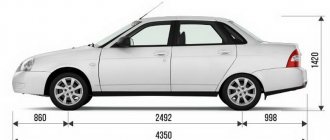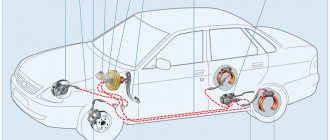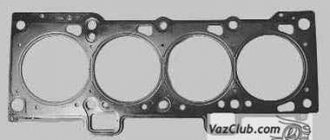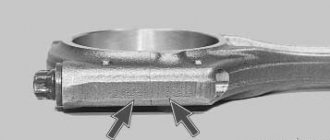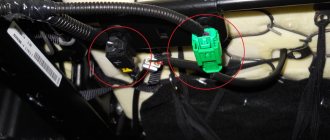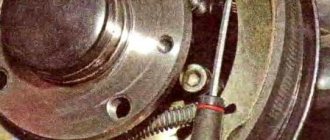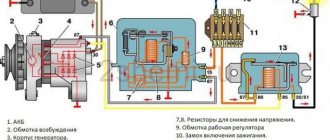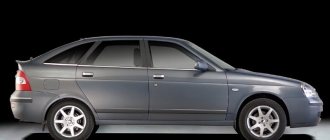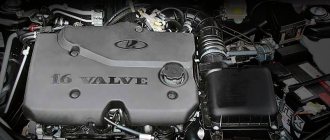Today, the automotive portal avtopromnews.ru published the first details about the new Lada Priora NFR 2022. The new product should be named Lada Priora NFR. A video from the model’s presentation has appeared online.
A message has appeared online that AvtoVAZ may in the very near future release a completely new generation of its legendary Lada Priora model, which will receive the abbreviation NFR in the name.
Lada Priora NFR 2nd generation will have nothing in common with its predecessor. According to the source, the car will also not be based on the budget CMF-B/LS platform of the Renault-Nissan concern. All future models from AvtoVAZ should be based on the latter. These include the new Lada Granta 2023 and the next generation Niva. What’s even more surprising is that, according to information leaked online, the Lada Priora in a new body should be built on the EMP2 platform of the Stellantis concern. Why did they decide to release the car now? As reported by avtopromnews.ru, the whole point is that the new Lada Priora NFR will be a completely different car of a higher class, on the border of the D/E segments. The NFR will compete with market bestsellers such as the Toyota Camry and Kia K5. The transition to the business sedan niche is associated with two factors.
- The quality of cars from AvtoVAZ has increased over the past 10 years
- The release of modern models like Vesta and Xray strengthened the brand image
Summary data for Lada Priora (before restyling 2013)
The VAZ 2170 (this is exactly the indexing that Priora received) has an improved interior compared to the “ten”, a 16-valve engine with a volume of 1596 cc. see, and a 5-speed manual transmission in all trim levels (in the first trim levels of the sedan and hatchback with an 80 hp engine, an 8-valve engine was installed). In mixed driving mode, the Priora has 100 km. it takes from 6.6 to 7.6 liters. fuel outside the city (depending on the configuration), and in the city - 9.8 liters. The new engine allows you to accelerate to 180 km/h, and to “hundreds” in 12 seconds. This property attracts the attention of fans of high-speed racing, because by working on the engine and tuning the car, you can achieve good sports performance.
Specifications
The VAZ Priora has a modernized engine with a displacement of 1.6 liters (with eight- and sixteen-valve cylinder heads), almost one hundred “horses”. The connecting rod and piston group has been lightened to the limit, which has reduced power losses by approximately 9 hp. With all this, the engine complies with Euro-3 standards in the standard version, Euro-4 in the “export” version, and now the process of bringing the engine characteristics into compliance with Euro-5 standards has been launched. But the announced increase in engine displacement to 1.8 liters never happened and is not even planned.
The gearbox is mechanical, with problematic gear shifting during acceleration inherited from the “ten”. The gearless electric power steering is beyond praise: in traffic jams the steering wheel can be rotated with just one finger; at speed, the assistance of the amplifier disappears. The gearbox drive mechanism with closed bearings and a reinforced clutch, as well as updated front suspension struts with barrel springs and rear suspension shock absorbers, distinguish the Priora from the “ten”.
A big and undoubted plus is that with the release of the Priora, driver airbags finally appeared in the basic configuration of AvtoVAZ models and a passenger airbag as an additional option.
Among the additional available bonuses, we should note heated front seats, air conditioning with climate control and a light and rain sensor - a trifle, but nice. Unfortunately, the reliability and build quality of the Priora leave much to be desired. A survey conducted by the analytical company clearly shows that Ladas (Priors and Kalinas) break down on average twice as often as foreign cars of the same price category. During the warranty period, 10% of Lada cars have problems with the suspension (versus 3-6% for inexpensive foreign cars), and 5% have problems with the gearbox. After the end of the warranty period, 10% of Lada cars have electric power steering and some other problems with the engine appear; 20% have problems with the suspension. And if we also take into account the fact that the Lada Priora breaks down on average more often than the Lada Kalina, the picture becomes completely bleak.
VAZ Priora car in the photo:
[ngg_images source=»galleries» container_ >
How much does Lada Priora weigh?
The weight of the car before restyling in 2013 was as follows:
- The 3-door hatchback coupe, 5-door hatchback and sedan have a curb weight (which includes the weight of a full tank of fuel and the driver) of 1088 kg. In this case, the total weight (i.e., the maximum permissible weight of the vehicle at which it can be operated after being fully loaded) is 1578 kg;
- The station wagon, with the same curb weight, is able to take a little more cargo, and its total weight reaches 1593 kg.
Thus, the station wagon is the most load-carrying of all Priora body types.
How long does a gas tank last?
With the maximum filling of the gas tank, the Lada Priora, powered by AI-95 (according to the passport!) will travel:
- 438 km in the city;
- 767 km on the highway;
- 597 km combined cycle.
However, the driving range on a full tank is given by us as a rough estimate, since depending on the configuration and modification it may vary slightly, although in all cases the volume of the gas tank is the same: 43 liters.
Video from the car presentation
The article talks about the best-selling passenger car in Russia - the Lada Priora. Where did the Priora come from, how does it differ from its derivative (“tens”), what characteristics does it have, and how is it planned (and whether it is planned) to modify and improve the Priora further - answers about all this can be found in the presented article.
Lada Priora is a Russian-made front-wheel drive car, the best-selling model of the LADA family, produced by AvtoVAZ OJSC since 2007. According to the European classification it belongs to class “C”.
Cargo capacity
Cargo capacity (not payload!) of the Prior varies depending on the body type. So, trunks have different volumes:
- 360 liters – for hatchback and coupe;
- 430 liters - for the sedan;
- 444 liters - for the station wagon.
As we can see, this volume is not very different from the sedan’s, so it’s a very stretch to say that the Priora station wagon was created to solve a wide range of economic problems (relative to other variants of this car). Of course, cargo capacity increases significantly if you fold the back of the rear sofa, or even better, remove the entire rear seat.
Comfort 4
This package will cost 461 thousand rubles; it will repeat the previous one, but will include the following:
- Possibility to recline the rear seat back.
- A high-quality multimedia system that will have its own display with a diagonal of 7 inches. The display is touch-sensitive, protected from glare, the system supports the ability to connect to a mobile phone using Bluetooth, you can use Handsfree. Music playback is provided through a removable drive connected via USB, it has its own SD card, and you can listen to the radio. Only two speakers can be set.
Dimensions of VAZ 2170 and other modifications of Priora
The dimensions of the car are something that needs to be taken into account when purchasing, since the dimensions of parking spaces, garages, turns or entrance arches are not always universal. The height is measured from the extreme point of the front to the extreme point of the rear bumper. The width is measured at the widest point, and the height is measured from the surface of the ground to the highest point of the roof. Roof rails and racks do not fit into the height of the body. Taking this into account, the dimensions of the Priora are as follows:
- The longest body of cars in this family is the sedan. It measures 4350 mm in length. But at the same time it is the lowest - 1420 mm. in height.
- The next longest is the station wagon, with its 4340 mm length. It is the highest in height – 1508 mm.
- The five-door hatchback and three-door coupe are the shortest - 4210 mm. at 1435 mm. in height.
In all four cases, the width of the Priora is the same - 1680 mm. Ground clearance is 165 mm, although in the Priora Sport configuration it is somewhat reduced, but this is no longer so important, since this car is no longer produced in this version.
Modifications of Lada Priora until 2013
VAZ 2170 Lada Priora I generation cars have the following body options: 4-door sedan, 5-door hatchback and station wagon, and 3-door coupe. Depending on the year of manufacture and configuration, engine power may vary, which looks like this.
Engine Lada Priora 2007, sedan, 1st generation
Based on the configuration, sedans before the 2013 restyling are equipped with the following engines:
- 80 “horses”: 8 valves, maximum speed 172 km/h, gasoline consumption – 7.6 liters. for every 100 km. in a mixed cycle.
- 16-valve engine with 89 hp. reaches speeds of up to 176 km/h, consuming 7.3 l/100 km. paths in a mixed cycle. As you can see, in terms of its characteristics, this engine is not much different from its “younger brother,” although it consumes a little less gasoline.
- 16-valve 98-horsepower engine: maximum speed 183 km/h, AI-95 consumption in the combined cycle – 7.2 l/100 km.
Engine Lada Priora 2008, hatchback, 1st generation
5-door hatchbacks have been produced since 2008. Depending on the configuration, they are equipped with:
- 80-horsepower 8-valve engine, delivering the same speed and fuel consumption characteristics as in the case of a sedan equipped with the same engine;
- 16-valve engine with 89 hp, which produces the same speed for a hatchback and consumes the same amount of gasoline as a sedan with the same engine;
- A 98-horsepower 16-valve engine, thanks to which the hatchback completely matches the speed and consumption characteristics of a sedan with the same power plant.
Engine Lada Priora 2008, station wagon, 1st generation
With a station wagon everything is simpler. From the very beginning of production, it had only one, but the most powerful engine at that time, producing 98 l/s, which accelerated the car to 183 km/h and consumed 7.2 liters of gasoline per 100 km. paths in a mixed cycle. Thus, despite the large cargo capacity of the station wagon, its rated speed remains the same as that of other Priors in a different body version, but with the same engine, since the curb weight is the same for all modifications. Probably, when fully loaded, the station wagon will show slightly lower speed or higher fuel consumption characteristics.
Engine Lada Priora 2010, coupe, 1st generation
Since 2010, Priora has received another modification - a three-door coupe-hatchback. Everything with him is also quite simple, because... It is equipped with a 98-horsepower 16-valve engine, giving a top speed of 183 km/h, consuming 7.4 liters of gasoline per 100 km in the combined cycle, i.e. slightly more than all other body modifications. As you can see, the station wagon and coupe do not have such a wide engine variation as the 5-door hatchback and sedan, since cars of such a body are not designed for wide sale, but for specific needs: sports and motor tourism. By the way, the creators of Priora had the idea to launch a convertible into series, but reasonably considering that it would not find its buyer, they abandoned this idea.
Restyling Lada Priora 2013
The 2013 restyling consisted of some changes regarding the appearance, some equipment, interior and engine. Among such changes in Prior we will name:
- A slightly modified exterior geometry, which, however, makes no sense to describe, since visually Priora before and after restyling remained almost indistinguishable in appearance;
- Replacing the radiator grille with an elongated “honeycomb”, slightly tilting the car into the now fashionable “organic” style, characterized by biological forms;
- Improved external lighting technology, thanks to which the car’s dimensions have become clearer in the dark. In particular, the area of the reflectors has been increased, LED sections for side lights and brake lights have been added, which are both brighter and more responsive when switched on;
- A dashboard that is implemented differently: instead of four “dials,” the sensor arrows were arranged in two, without compromising functionality. Purely aesthetically it looks better, but from an ergonomic point of view, a lot depends on habit;
- An increased number of pictograms flashing on the dashboard, making it easier to figure out which lighting equipment is faulty;
- An added niche in the center of the dashboard, in which the on-board computer is placed;
- Extended front seat slides, allowing tall drivers and front passengers to adjust their seat positions more flexibly;
- A box that is more spacious in depth to the right of the driver;
- A more attractive three-spoke steering wheel with an airbag under a triangular cover;
- In the “luxury” configuration – leather upholstery based on a combination of auto fabric and eco-leather;
- New door card design.
Also, since 2013, Priors have been produced in a different engine configuration, from which the 80-horsepower engine was removed, but a new 106 l/s engine was added, which, like everyone else, reaches speeds of up to 183 km/h and reduces fuel consumption to 6. 8 – 6.9 liters per hundred km. This engine is equipped with the “luxury” configurations of the Priora. Of course, such a reduction in fuel consumption is very attractive to the consumer. We can only hope that the developers will continue to work in this direction. In addition, the new engine fits well into Euro-3 and Euro-4 environmental standards, thanks to the closely located catalyst. Due to rapid heating, the catalysis of toxic substances occurs more vigorously, as a result of which a lower concentration of them enters the atmosphere.
The restyled Prior also has a drawback (compared to previous editions of this car): the carpet in the trunk is thinner than its predecessors, which is why the noise level while driving is higher. Motorists are advised to take care of additional sound insulation in the trunk. In addition, the curb weight of the car has increased (to 1185 kg), which is by as much as 100 kg. reduced its cargo capabilities, since the maximum weight remained the same - 1593 kg. for a station wagon, and 1578 kg. for other body variations.
Standard
This is the basic package, the cost of which will be 387,000 rubles. It will include:
- One airbag provided for the driver's seat.
- ISOFIX child seat mounting system.
- ABS, EBD, BAS.
- Headrests.
- Signaling.
- Electric power steering.
- There will be no radio, only audio preparation.
- Front windows.
- Exterior mirrors will be heated and electrically driven.
- The seats are heated.
- Climate control can be installed for an additional fee.
- Discs are installed either R 13 or R 14.
- The Special Edition interior is available for an extra charge.
Configurations of Lada Priora VAZ 2170 and other modifications
VAZ 2170 is known in the following configurations:
- “Standard” is the most budget package. It lacks: audio radio, speakers, air conditioning, rear headrests, immobilizer, central locking, heated front seats, electric drive and heated exterior mirrors, fog lights, remote trunk release. The front windows are electric, the rear windows are mechanical. The engine is 81 hp, which has been discontinued since 2013, and at the moment there are no longer orders for this configuration;
- “Norma”, which is equipped with an 87-, and after restyling - only a 98- and 106-power engine. Available: audio preparation, on-board computer, electric heating and electric drive of exterior mirrors, immobilizer, anti-theft alarm and all the elements of the “standard” equipment plus some new equipment. This configuration is in greatest demand due to its price niche. When you need a car “yesterday”, you have to buy what you have enough money for now, and everyone else has to retrofit the car in the process.
- "Norma+". In fact, this is the same standard for which one or more items of equipment are set: air conditioning, audio radio with speakers, ABS + BAS, child seat mounts, heated front seats and windshield;
- “Lux” is the most rich in functionality. It has everything that the “norm+” has, and in addition: side airbags, an airbag for the front passenger, rear and front electric windows, a navigator, a multimedia system, cruise control, parking sensors, fog lights, a rain sensor, a climate system , alloy wheels, heated front seats;
- “Sport” is a special package that increases the “sports” component. This is an aerodynamic body kit: a pronounced bumper with a spoiler, side sills, a diffuser rear bumper, and a wing on the trunk lid. The wheels with narrow profile tires are also different. Ground clearance, curb weight (up to 1080 kg) and maximum weight (up to 1500 kg) have been reduced. The interior has also been transformed: side supports have been added along the edges of the seats with red stitched seams, carbon fiber inserts, and a leather steering wheel. Air conditioning, radio, and a full set of electric windows are included. However, the production of sports Prioras was limited and today they are discontinued, although they can be found here and there on the highway, and most often these are Priora coupes.
Of course, this is not a complete, but only an indicative overview of the configurations of the Lada Priora, which is hardly possible to present in its entirety within the confines of one article. In addition, the equipment also differs somewhat depending on the body type. For example:
- Prior station wagons have roof rails, brackets on the wheel arches of the trunk, for which cargo can be strapped;
- For the coupe body, folding backrests and a reinforced frame of the front seats have been developed.
Why did you choose the EMP2 platform for the Priora in the new body?
According to the source, the choice of a third-party platform was caused by the need to load the assembly plant in Kaluga. This site is jointly owned by Stellantis and Mitsubishi. Mitsubishi itself has recently been part of the Renault-Nissan concern. All this makes the partnership of the two corporations a completely logical move. Stellantis currently assembles commercial vehicles and outdated Peugeot 408 and Citroen C4 models at this car plant. Demand for the latter has dropped to almost zero. In order to revive production, fresh models are needed. This could be the relatively affordable Peugeot 2008 crossover, which is currently being imported to Russia. The model is based on the EMP2 platform. At the same time, mastering the production of cars on a new platform is quite risky. If you fail to achieve high sales figures, the project may turn out to be unprofitable. Russians have not been favoring French brands lately.
From the above, it becomes clear that the production of a model on a new breed platform by the well-known Lada brand in Russia can be a good safety net. Full-size sedans are in good demand in our country, subject to a reasonable pricing policy. Take, for example, the extremely successful Toyota Camry and Kia K5. The new Lada Priora should be in no way inferior to its competitors with a more humane price tag, which means we can fully count on stable demand. Moreover, the price of foreign cars has grown very much over the past year (by 20% only according to the RRP), and there are also markups from dealers.
At the same time, the reputation of the Lada brand has grown greatly in recent years. Successful models like Vesta have proven themselves to be very good. Even the Lada Granta, after a series of modernizations, has become significantly better in terms of consumer qualities. The release of a higher-class model, which should be the new Lada Priora NFR, seems to be a completely logical move in such a situation.

